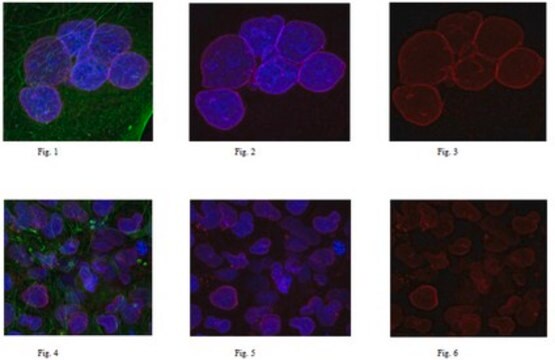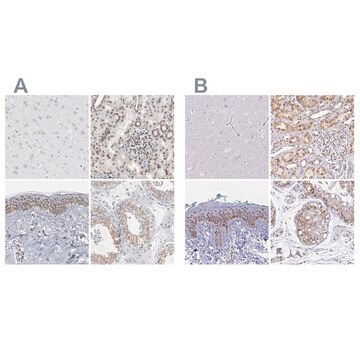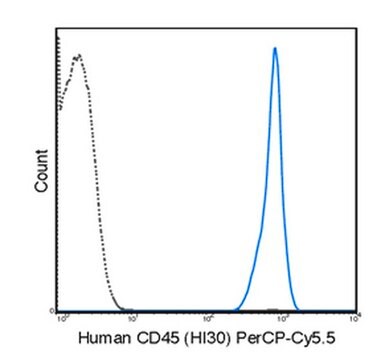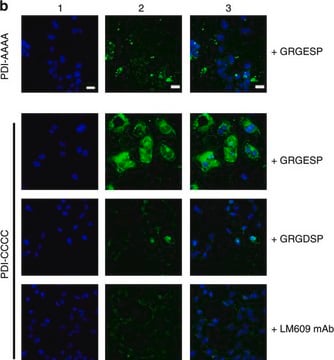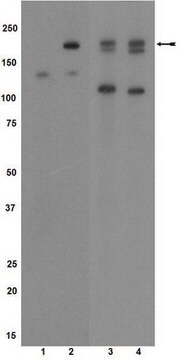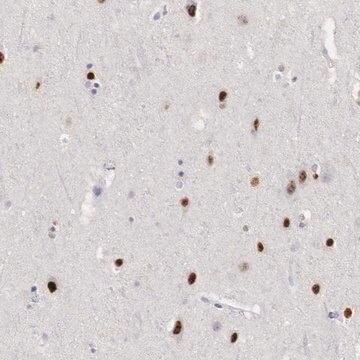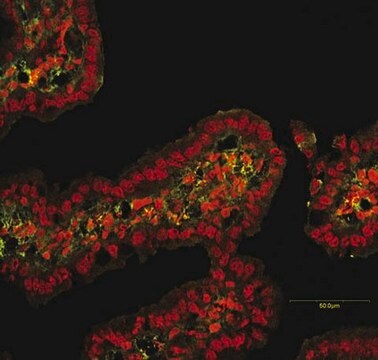MABN857
Anti-SYNE1 Antibody, clone 200A6
clone 200A6, from mouse
Synonym(e):
CPG2, Enaptin, Enaptin-165, Nesprin-1 Giant, Syne-1B
About This Item
Empfohlene Produkte
Biologische Quelle
mouse
Qualitätsniveau
Antikörperform
purified immunoglobulin
Antikörper-Produkttyp
primary antibodies
Klon
200A6, monoclonal
Speziesreaktivität
rat
Speziesreaktivität (Voraussage durch Homologie)
mouse (based on 100% sequence homology)
Methode(n)
electron microscopy: suitable
immunocytochemistry: suitable
western blot: suitable
Isotyp
IgG1κ
GenBank-Hinterlegungsnummer
NCBI-Hinterlegungsnummer
Versandbedingung
ambient
Posttranslationale Modifikation Target
unmodified
Angaben zum Gen
mouse ... Syne1(64009)
Allgemeine Beschreibung
Spezifität
Immunogen
Anwendung
Neurowissenschaft
Electron Microscopy Analysis: A representative lot localized SYNE1 isoform CPG2 immunoreactivity colocalized with clathrin in the postsynaptic endocytic zone by immunoEM labeling of 60 nm thick serial sections of 4% paraformaldehyde-/0.1% glutaraldehyde-fixed rat neurons (Cottrell, J.R., et al. (2004). Neuron. 44(4):677-690).
Immunocytochemistry Analysis: A representative lot immunolocalized SYNE1 spliced isoform CPG2 on the dendritic spines, colocalized with clathrin, but segregated from the PSD and actin filaments in the spine head, by fluorescent immunocytochemistry staining of 4% formaldehyde-fixed, 0.3% Triton X-100-permeabilized rat hippocampal neurons. Target staining was greatly diminished among neurons received cellular CPG2 shRNA delivery (Cottrell, J.R., et al. (2004). Neuron. 44(4):677-690).
Western Blotting Analysis: A representative lot detected SYNE1 spliced isoform CPG2 as a ~110 kDa boublet band in rat cerebral cortex tissue extract and lysate from isolated rat cortical neurons. Target band detection was greatly diminished when using lysate from neurons following cellular CPG2 shRNA delivery (Cottrell, J.R., et al. (2004). Neuron. 44(4):677-690).
Qualität
Western Blotting Analysis: 4 µg/mL of this antibody detected the ~110 kDa SYNE1 spliced isoform CPG2 in 10 µg of rat hippocampus tissue lysate.
Zielbeschreibung
Physikalische Form
Lagerung und Haltbarkeit
Sonstige Hinweise
Rechtliche Hinweise
Haftungsausschluss
Sie haben nicht das passende Produkt gefunden?
Probieren Sie unser Produkt-Auswahlhilfe. aus.
Lagerklassenschlüssel
12 - Non Combustible Liquids
WGK
WGK 1
Flammpunkt (°F)
Not applicable
Flammpunkt (°C)
Not applicable
Analysenzertifikate (COA)
Suchen Sie nach Analysenzertifikate (COA), indem Sie die Lot-/Chargennummer des Produkts eingeben. Lot- und Chargennummern sind auf dem Produktetikett hinter den Wörtern ‘Lot’ oder ‘Batch’ (Lot oder Charge) zu finden.
Besitzen Sie dieses Produkt bereits?
In der Dokumentenbibliothek finden Sie die Dokumentation zu den Produkten, die Sie kürzlich erworben haben.
Unser Team von Wissenschaftlern verfügt über Erfahrung in allen Forschungsbereichen einschließlich Life Science, Materialwissenschaften, chemischer Synthese, Chromatographie, Analytik und vielen mehr..
Setzen Sie sich mit dem technischen Dienst in Verbindung.